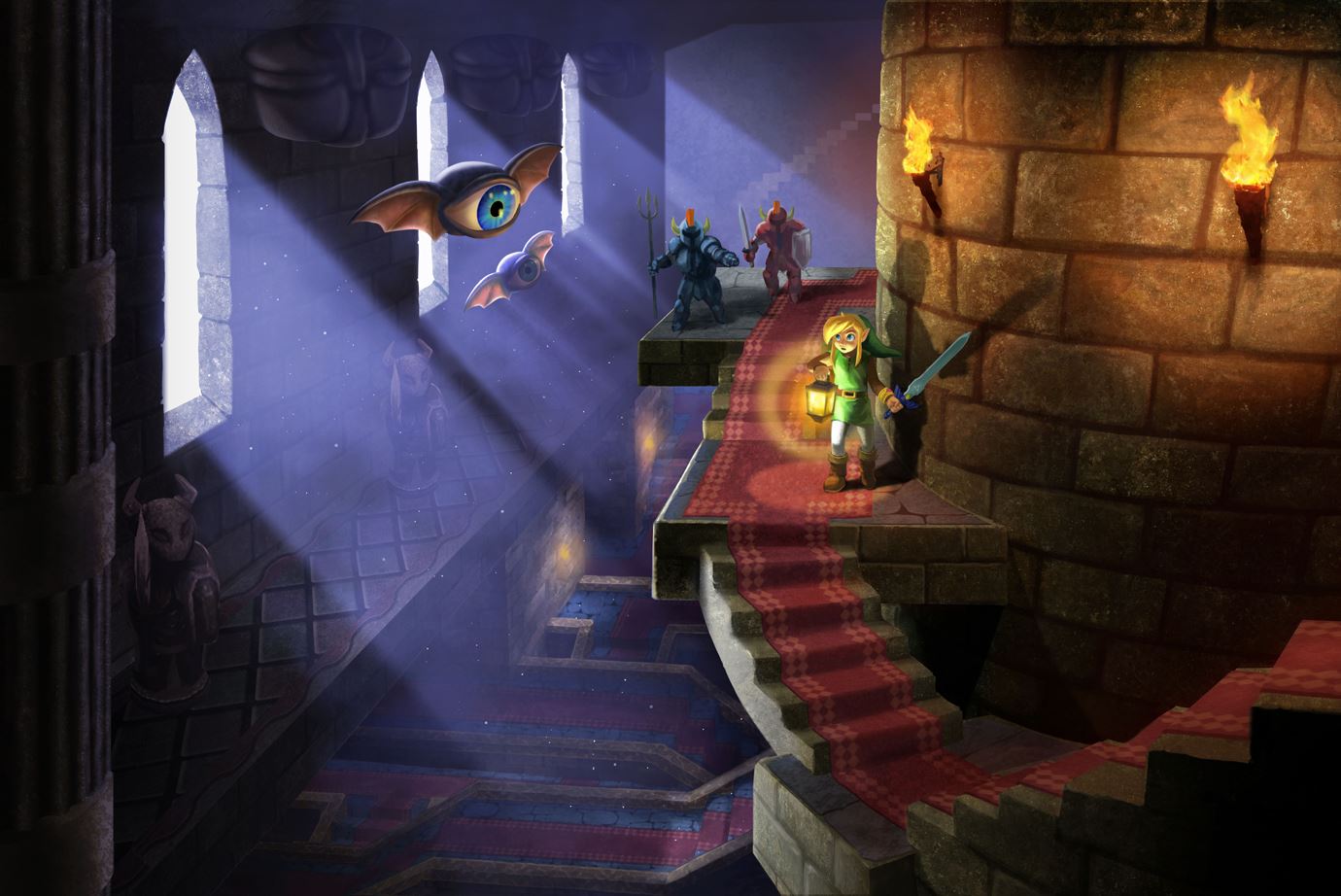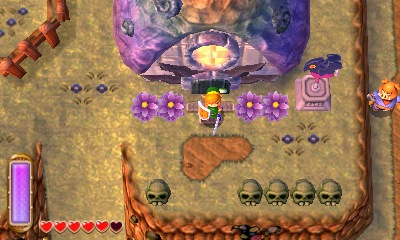Oh, Zelda.
We have an amazing relationship. Every year or so, Nintendo releases some sort of entry in the Zelda franchise. To make up for our Zelda-less 2012, however, Nintendo decided to not only release The Legend of Zelda: The Wind Waker HD, but also a new game, A Link Between Worlds.
As you likely already know, A Link Between Worlds is very much a sequel to A Link to the Past, one of the most iconic titles in the franchise and usually the only one to tie or win out over Ocarina of Time for best Zelda game or even best game of all time.
The Legend of Zelda: A Link Between Worlds is a step in a new direction for the Zelda franchise, despite it firmly planting its roots by being a sequel (and one of the few sequels in the series, to boot). Back in January, Eiji Aonuma, director and producer of The Legend of Zelda since 1998, told us that he would eschew some traditional Zelda mechanics in favour of a new play style. A Link Between Worlds is the first game in the series in which Nintendo does just that, and the result is a wonderful game.
Height and dimension are the name of the game in A Link Between Worlds. The game doesn’t require 3D per se, but it looks beautiful with it switched on, even if just slightly. Everything in this game is crafted around different levels, whether with hills in the over world, or moving platforms in a dungeon. And while it might seem difficult to understand what level you’re on, some wonderful design choices have been made to make the game easier to perceive. The level you’re on is always slightly brighter than the others, giving you a subtle visual cue as to whether or not you’ll be able to get to the platform on the other side of the room, or if it’s not worth trying at this point.

Height in the game also factors alongside lighting. This is especially true when you venture into Lorule, as darkness can be interrupted by furious lightning that casts beautiful shadows, even down the bottomless pits of this dark world. Spawn a blast from your fire rod, and the area erupts with light around it as well, a true feat for a portable console.
Early on in the development of A Link Between Worlds, the design team made a decision to have the game render in a full sixty frames per second. This might not sound like a huge deal, what with the Xbox One and PlayStation 4 now unleashed to the world, but on a portable console that also happens to do full 3D, it’s huge. Not once did the game lad or stutter, and we may have noticed a total of ten frames drop through the entire game. And even then, we really had to be paying attention.
Other things, like becoming a drawing and traversing the walls, as well as the clang of iconic crystal switches, is satisfyingly beautiful, with shine and reflection we haven’t seen in a handheld Zelda game before.
Much like the visuals seem to revolve around height, the audio in A Link Between Worlds sticks to one theme, and it sticks to it well: incredibly well-crafted, orchestral audio. This isn’t a small handheld title from an audio standpoint. This game could more than easily stand up to the Halos and the God of Wars of the world. In fact, the game at times feels like a Peter Jackson or George Lucas epic with a score from the likes of John Williams far more than it does a game designed by the same guys who make Mario.
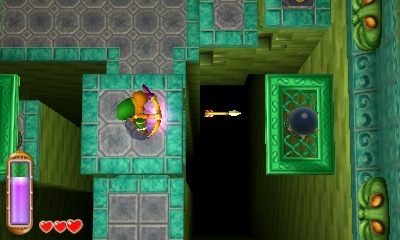
There are subtle changes in audio in certain modes that make the world feel more realistic. When Link merges into the wall, the audio fades slightly, becoming a bit more hollow and mellower. It’s as if Nintendo knows what it would sound like if our ear drums were compressed into a painting on brick, and it’s showing us just that.
The best way we know how to describe the audio in A Link Between Worlds is to show you. Hop back to June and have a listen to the audio from Nintendomination’s direct recording of the gameplay demo.
Save the princess, right? Sure, that might not be a surprise for Zelda or Nintendo fans in general. But the way this story plays out is much different than what you might expect from a Zelda title. The evildoer this time around, Yuga, is a menacing character, trapping the sages of the world into paintings. It’s more gruesome and terrifying than we usually get in a game from this series, but it’s an interesting twist away from the otherwise childish design of the title.
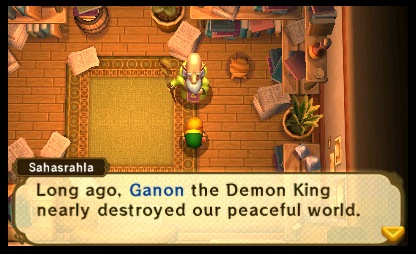
Rather than just playing through a bunch of dungeons to get to the princess, however, you traverse multiple worlds and weave between Hyrule and Lorule. The overall mechanic is the same in that you must collect a bunch of different elements to progress through the experience, but the way you go about everything is much different.
Gone are the days of fetch quests between dungeons, though they are certainly an option if you decide to pursue them. The story actually becomes a much bigger factor in between-dungeon play, as it were, including a stealth sequence that is actually quite fun, and not cringe worthy. It’s fast-paced and strategic, and surprisingly un-Zelda in its execution.
There’s also the ability to rent items to let you play through the dungeons in any order, and while we opted to rent everything from the beginning, players who want to challenge themselves should be able to get by with only a single item in each dungeon, provided they know what they need ahead of time.
SpoilerYou can get the Hylian shield in the game, though you don’t need to. What was most bothersome is that the Hylian shield doesn’t ever get mentioned beyond its first appearance in the game, in a random dungeon, after completing a random puzzle. But yes, for series purists, it’s there. And it’s beautiful.
The story in A Link Between Worlds isn’t the most unique or original in the series, but it’s certainly one of the better ones, only bested by the stories of The Wind Waker, Ocarina of Time, and Skyward Sword.
Controlling Link is where everything comes together, especially considering this game’s roots. As a sequel to one of the best-playing Zelda games of all time, Link needed to play perfectly for this game to be a success. Thankfully, he does.
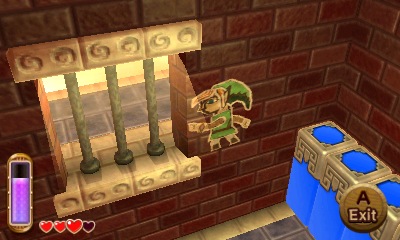
Sword slashing, bomb throwing, and fire rod blasting are all as satisfying as ever, and while the game changes up the way some mechanics work, it’s for the better. For example, if feels like bombs go off a bit quicker, which is nice for time management, but also makes things a bit trickier when you leave a bomb next to a switch and wait for it to go off. Arrows are barely used this time around, though we can’t say we missed them, with the cool additions of the sand rod and tornado rod taking up the reigns for new items. The boomerang got precisely three uses, all within about five minutes of each other. We’re not sure we ever equipped it again after that.
With A Link Between Worlds comes the promise of a less linear Zelda experience, and Nintendo has delivered. The game follows a very typical three small dungeons followed by another half dozen (or in this case, seven) dungeons of increasingly difficulty, however it does that in a different way. The first three dungeons are some of the easiest we’ve ever played, but they require a fair bit of strategy to traverse. This is when you’re first learning about wall-drawn Link and all its benefits, so it can be a bit of a trick to navigate mazes, especially the one within the Tower of Hera.
Once through the first set of dungeons, Link is given the option to play through almost any other dungeon in the game, the one exception being the Desert Palace, which requires the sand rod, an item you get once you’ve played through the Thieves’ Hideout.
What’s most refreshing about the ‘play in any order’ mechanic is that the game doesn’t rely on it as its only differentiator. The nature of the story prevents the game from devolving into total chaos as certain items can only be obtained by certain characters. In fact, it’s also possible to play through the entire game without one item that you might think would be necessary if you’ve played previous games in the series.
SpoilerThe pegasus boots are not required to complete the game.
The first few hours of A Link Between Worlds are dreadfully easy, to the point that we legitimately started to worry that, like Pokémon X and Y, Nintendo had caved to pressure to get an easier game into the hands of more people. Luckily, difficulty ramps up rather quickly after the three pendants are found by around the fourth hour or so, and the game takes on the tone it will have for the remainder of the experience.
Difficulty is something that doesn’t really fluctuate throughout the course of the adventure. Since you can play through dungeons in any order, the game doesn’t have the usual ascending difficulty of previous titles in the franchise. Rather, each dungeon is right around where the fifth dungeon in a more traditional Zelda game might be in terms of difficulty. It’s understandable that the designers couldn’t possibly know which order you’d play the game in, so difficulty would have to remain relatively level. With that said, however, it would’ve been an interesting mechanic to see monsters be more difficult in a dungeon depending on how many sages you had rescued to that point.
What Nintendo removes from a difficulty standpoint, it includes with strategy. The game is not unlike a platforming Mario game in some senses, especially with the moving platforms of dungeons. Puzzles are so well-designed in A Link Between Worlds that we could go ahead and say that they’re only beaten by the brilliance of those found in Skyward Sword.
Designers have used everything at their disposal to make these puzzles challenging from an intellectual place rather than a purely difficult one. Figuring out that Link needs to pop out of a wall behind a platform to make it fall and create a bridge was a thrilling moment, as was snuffing out a torch to discover that a room glows when there is no light to drown it out. There are, without a doubt, some of the best strategic moments in the Zelda franchise in A Link Between Worlds.
Saving mechanics are worth discussing in Zelda games since they can be a sour point. In A Link Between Worlds, you awaken weathervanes you find around both Hyrule and Lorule. These are how you’re able to save your game, as well as how you can travel from one end of the world to another very quickly. We much prefer the ability to save anywhere in the game, though with the sleep function of the 3DS, it isn’t a deal breaker by any means.
An odd thing to discuss for a Zelda game is the addition of multiplayer. Via StreetPass, you can meet other Links (known as Shadow Links) to battle them with the items you have. If you win, you get a bounty that the game places on their head, which is a combination of their items, strengths, and number of heart containers. The battle consists of little more than an AI opponent fighting your Link as you try to deliver more sword slashes to defeat him. It’s a bit bizarre and a sorry excuse for a multiplayer component to the game, and it’s probably our only major gripe with the game. It would’ve been better to have done nothing at all than to do multiplayer so poorly.
Nintendo has managed to create something that is truly worthy of being a successor to one of the best and most popular Zelda titles of all time. The game is remarkably well-crafted, and stands on its own as the best reason to own a 3DS or 2DS.
In a world filled with next-gen hype created by the Xbox One and PlayStation 4, Nintendo has managed to create something worth playing on a console that is about to celebrate its third birthday.
Oh, Zelda.

